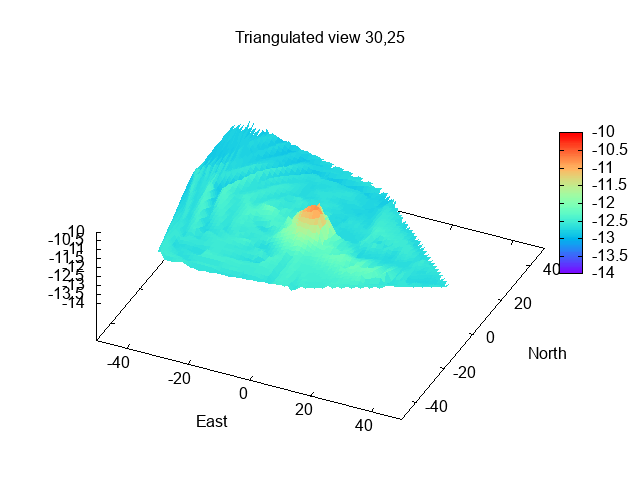
Eversfield p 123
The position given is based on a MDHB report of "about 2 miles SE from Horse Channel Fairway Buoy" from 1888. I have searched with a magnetometer in this area - and find no return.
There is a survey report of a significant magnetometer
return [1400nT] and an associated sonar signal [area 22m by 4m, rising
2m with scour] at about 500 metres SSW from that listed position [so 2.2
miles at 138.5° from the Horse Channel Fairway Buoy].
Note that the Angola, wrecked in 1887, was
found by me, and reported in Wrecks of Liverpool
Bay Volume 2, to be about 500 metres from the MDHB reported postion.
This might prove to be the Eversfield, but visibility is
often poor in this area due to silt, so it is not easy to check by
diving [but see 2021 dive report here, including
images from dive, and 2022 dive report]. Divers report
no sign of engine, but wooden beams, and a large anchor and chain. A flat
would typically have an anchor of weight about 1/1000 of her
displacement tonnage - which is listed as 170 tons [Eversfield was a
lengthened flat - also described as a small coaster]. So anchor of
around 170Kg - which is consistent with the apparent weight of the anchor
on the wreck [shaft 8-10cm diameter and 1.5-2.0m long, so weighing
around 80Kg]. Magnetometer signal is sufficiently strong to suggest
more iron on the wreck than the anchor and chain. Lack of diver's
evidence of engine components means no definite confirmation that this
location is the Eversfield.
The position of the wreckage (sonar peak) is 53° 27.989N, 3° 17.474W, with the biggest magnetometer signal SE of this. Note that this location is within the Burbo Extension Wind Farm, so anchoring is not permitted.
My sonar plot (depths and distances in metres)

Some more details of the Eversfield (WLBv2 states: sank 31 Jan 1888, carrying limestone
from Llanddulas to Widnes; crew saved in own boat; masts removed by MDHB)
are now known:
She was built at Wivenhoe (near Colchester) in 1852 as a wooden screw steamer of 60 x 17ft
with tonnage 51g/35n and 30 hp engine. ON 26648.
MNL records: she was owned by Thomas Winder of Liverpool 1874 to 1878,
registered at Liverpool, and she had been lengthened by 1875 to 95.5ft
with size 123grt, 71nrt, 30hp screw [width 19.5, depth 9.0ft].
Ownership changed to G. Cowl 1879, J. Heathercock 1880-4, Thomas
Williams 1885, D. Macwatty 1886-8; all at Liverpool.
Newspapers record her skipper in 1886 as Duncan MacWatty.
In February 1887, she landed purple ore from Widnes at Workington
Liverpool Journal of Commerce - Saturday 14 August 1886:
On Thursday,
the 2nd Sept, at a Quarter-past Twelve o'clock, at the Saleroom,
Exchange-buildings, Rumford-street, Liverpool.
The Screw-Steamer
EVERSFIELD 123 tons gross and 70 tons net register. Length, 95 ft 5-10;
breadth, 19ft 5-10; depth, 9ft. Built at Wivenhoe in 1852, but
lengthened, raised, and rebuilt in 1874. Has large main hatch; carries
170 tons deadweight on 8.5 feet. Has new engines, and her boiler was
new in 1882, and is now in excellent order. Lying in George's Dock.
Warrington Examiner - Saturday 04 February 1888:
FOUNDERING OF A WIDNES STEAMER.
On Monday night, a strong gale was blowing off Liverpool, and
resulted in the foundering of the coasting steamer the Eversfield, bound
to the Mersey with a cargo of limestone. The disaster occurred near the
northwest lightship at four o'clock on Tuesday morning [31 January
1888]. The crew abandoned their vessel, leaving in one of their own
boats. They were only just in time, for the steamer foundered soon
after they left, going down in 10 fathoms of water. The heavy nature of
her cargo aided her in going down very quickly. The men in their tiny
craft made for the Mersey, and although the weather was heavy, they
succeeded in getting to the George's Landing-stage, where they landed on
Tuesday. The Eversfield was only a small steamer of 123 tons. She was
bringing the limestone from Llandulas, and had been for some time
engaged in that capacity. She belonged to Mr. L. Kilcross, of Widnes.